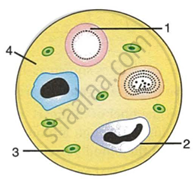Advertisements
Advertisements
Question
Given alongside is a diagram of a smear of human blood. Study the same and answer the questions that follow:
 |
- Name the parts l, 2, 3 and 4 indicated by guidelines.
- Mention two structural differences between the parts labelled 'l' and '2'.
- What is the main function of the parts labelled 1, 2 and 3 respectively?
- What is the life span of the part labelled '1'?
- Name a soluble protein found in '4' which helps in the clotting of blood.
Solution
-
- RBC's (Erythrocytes)
- WBC (Platelets)
- Blood Platelet
- Plasma
- RBCs are biconcave and disc-like, while WBCs have an irregular amoeboid shape.
RBCs are smaller in size and devoid of nuclei. Meanwhile, WBCs are larger and have a nucleus. - Functions of:
- RBCs (erythrocytes): It contains haemoglobin pigment, which helps transport oxygen.
- WBC (Platelets): WBCs protect the body against infections, thus making them called soldiers of the body.
- Blood Platelet: Blood platelets are the initiators of blood clotting.
- The average life of RBC is about 120 days.
- Fibrinogen.
APPEARS IN
RELATED QUESTIONS
The mineral ion needed for the formation of blood clot is :
A. Potassium
B. Sodium
C. Calcium
D. Iron
Give appropriate biological or technical terms for the following:
Squeezing out of white blood cells from the capillaries into the surrounding tissues.
What are the functions of blood plasma?
The compound formed when haemoglobin combines with carbon dioxide in blood.
Select the odd one in the following:
Monocytes, Lymphocytes, Basophils, RBC
Choose the correct answer:
How much blood is present in an average person?
The table below is designed to indicate the major arteries emerging from the aorta and supplying blood to different organs.
Fill in the blanks with suitable answers.
| Name of the Artery | Supplying to | |
| (i) | Kidney | |
| (ii) | Genital | |
| (iii) | Right forelimb | |
| (iv) | Phrenic | |
| (v) | Liver | |
| (vi) | Chest |
Explain the Term
Diapedesis
Complete the following sentence with appropriate word:
The iron pigment __________ gives red colour to the blood.
Multiple Choice Questions
Which protein is used in preventing clotting of blood?
